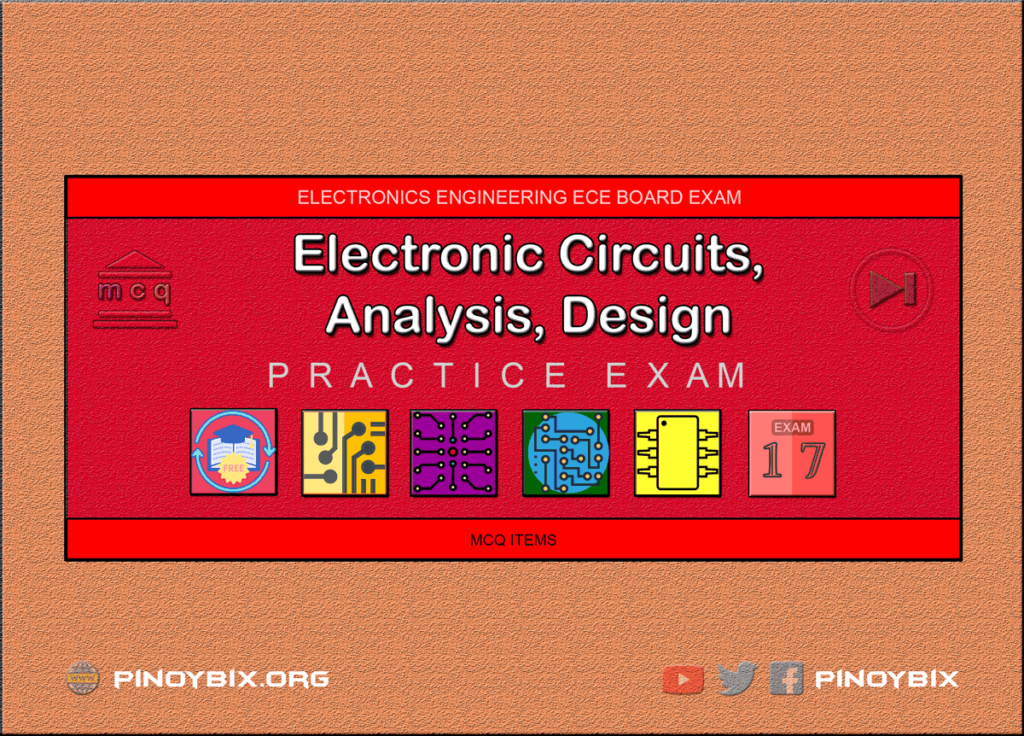
This is the Multiple Choice Questions in Electronic Circuits (Electronic Devices and Circuits, Electronic Circuit Analysis and Design) Part 17 of the Series as one of the Electronics Engineering Examination topic. In Preparation for the ECE Board Exam make sure to expose yourself and familiarize in each and every questions compiled here taken from various sources including but not limited to past Board Exam Questions in Electronics Engineering field, Electronics Books, Journals and other Electronics References.
MCQ Topic Outline included in ECE Board Exam Syllabi
4. Electronic Devices and Circuits
- MCQ in Diode Wave Shaping Circuits and Special Diode Applications
- MCQ in BJT and FET Small Signal Analysis
- MCQ in Diode Equivalent Circuits
- MCQ in Voltage Multipliers, Power Supply, and Voltage Regulation
- MCQ in Bipolar Junction Transistor and FET
5. Electronic Circuit Analysis and Design
- MCQ in BJT and FET Frequency Response
- MCQ in Cascade and Cascode Connections
- MCQ in Current Mirrors and Current Source
- MCQ in Differential and Operational Amplifier
- MCQ in Feedback Systems, Oscillators, and Filters
Continue Practice Exam Test Questions Part 17 of the Series
⇐ MCQ in Electronic Circuits Part 16 | ECE Board Exam
Choose the letter of the best answer in each questions.
801. A roll-off of 20 dB per decade is equivalent to a roll-off of ________ per octave.
A. 3 dB
B. 13 dB
C. 12 dB
D. 6 dB
Answer: Option D
Solution:
802. A certain amplifier has a bandwidth of 22.5 kHz with a lower cutoff frequency of 600 Hz. What is the value of fcu?
A. 600 Hz
B. 22.5 kHz
C. 23.1 kHz
D. 21.9 kHz
803. For low-frequency response, all RC circuits in an amplifier may not have the same critical frequency. Which RC response will determine the critical frequency of the amplifier?
A. the lowest frequency
B. the center frequency
C. the highest frequency
D. the bypass frequency
Answer: Option A
Solution:
804. An amplifier has an output voltage of 7.6 V p-p at the midpoint of the frequency range. What is the output at fc?
A. 3.8 V p-p
B. 3.8 Vrms
C. 5.4 Vrms
D. 5.4 V p-p
805. Refer to this figure. The capacitor C3 affects

A. high-frequency response.
B. low-frequency response.
C. midrange response.
D. nothing.
Answer: Option D
Solution:
806. Refer to the previous figure. The capacitor Cbe affects
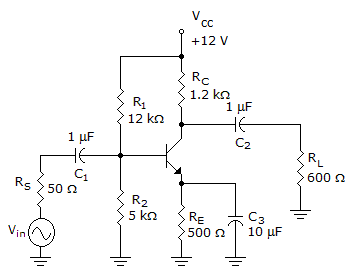
A. high-frequency response.
B. low-frequency response.
C. midrange response.
D. nothing.
Answer: Option A
Solution:
807. Refer to the previous figure. The upper cutoff frequency of this amplifier is 22 kHz. The output at that frequency is 6.71 V p-p. What is the output voltage at 220 kHz?
A. 9.49 V p-p
B. 6.71 V p-p
C. 0.671 V p-p
D. 0.0671 V p-p
808. What is the cutoff frequency of an op-amp if the unity-gain frequency is 1.5 MHz and the open-loop gain is 100,000?
A. 5 Hz
B. 10 Hz
C. 15 Hz
D. 20 Hz
809. Identify the frequency response curve for a band-reject filter.
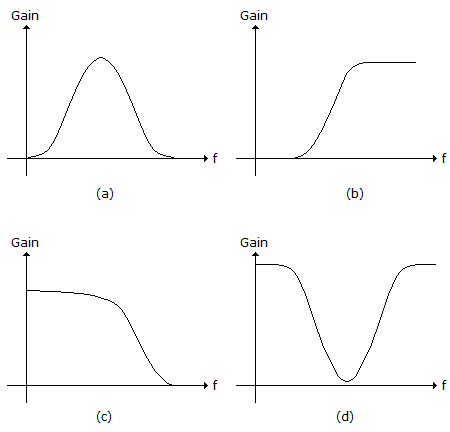
Answer: Option D
Solution:
810. The output of an RC integrator is taken across the

A. diode
B. capacitor
C. resistor
D. source
Answer: Option D
Solution:
811. In which of the following operations is the resulting output signal of the differential amplifier near zero?
A. Single-ended
B. Double-ended
C. Common-mode
D. None of the above
Answer: Option C
Solution:
812. If an op-amp has one input grounded and the other input has a signal feed to it, then it is operating as what?
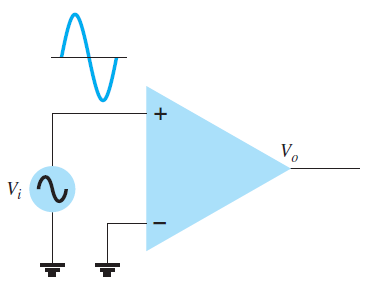
A. Common-mode
B. Single-ended
C. Double-ended
D. Noninverting mode
Answer: Option B
Solution:
813. What is the difference output voltage of any signals applied to the input terminals?
A. The differential gain times the difference input voltage.
B. The common-mode gain times the common input voltage.
C. The sum of the differential gain times the difference input voltage and the common-mode gain times the common input voltage.
D. The difference of the differential gain times the difference input voltage and the common-mode gain times the common input voltage.
Answer: Option C
Solution:
814. A practical op-amp has very ________ input impedance, very ________ output impedance, very ________ open loop voltage gain, and a ________ bandwidth.
A. high, low, high, wide
B. high, high, low, narrow
C. low, high, high, wide
D. low, low, low, wide
Answer: Option A
Solution:
815. It takes an op-amp 22 µs to change its output from –15 V to +15 V. Determine the slew rate.
A. 1.36 V/µs
B. 0.68 V/µs
C. –0.68 V/µs
D. cannot determine
816. Open-loop voltage gain of an op-amp can range up to ________.
A. 10,000
B. 50,000
C. 100,000
D. 200,000
Answer: Option D
Solution:
817. A differential amplifier has a common-mode gain of 0.2 and a common-mode rejection ratio of 3250. What would the output voltage be if the single-ended input voltage was 7 mV rms?
A. 1.4 mV rms
B. 650 mV rms
C. 4.55 V rms
D. 0.455 V rms
Answer: Option C
Solution:
Solution: What would the output voltage be if the single-ended input voltage was
818. Refer to the given figure. This circuit is known as
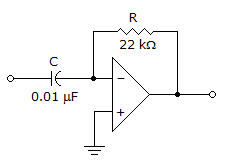
A. a noninverting amplifier.
B. a differentiator.
C. an integrator.
D. a summing amplifier.
Answer: Option B
Solution:
819. Refer to the given figure. What is the output voltage?
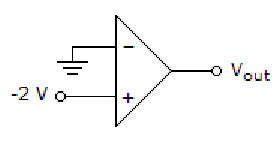
A. 2 V
B. –2 V
C. +Vsat
D. –Vsat
820. Refer to the given figure. If Vin = 5 V, the rate of change of the output voltage in response to a single pulse input is:
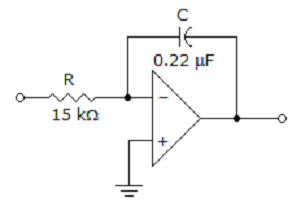
A. 15.2 mV/µs
B. 1.52 V/µs
C. 1.52 mV/µs
D. 15.2 V/µs
Answer: Option C
Solution:
Solution: The rate of change of the output voltage in response to a single pulse input
821. Refer to the given figure. Determine the output voltage, VOUT.
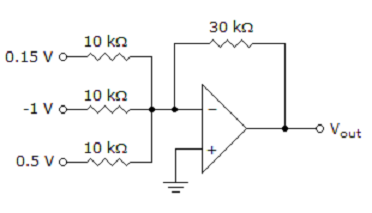
A. 1.05 V
B. –0.35 V
C. 0.35 V
D. –1.05 V
822. Calculate the output voltage.
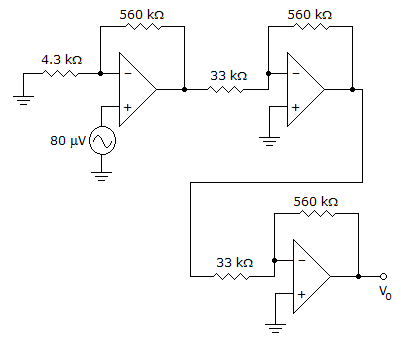
A. 3.02 V
B. 2.03 V
C. 1.78 V
D. 1.50 V
823. Refer to the given figure. This circuit is known as a ________ filter, and the fc is ________.
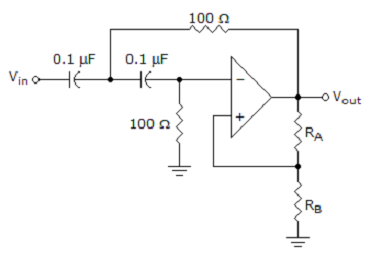
A. high-pass, 1.59 kHz
B. band-pass, 15.9 kHz
C. low-pass, 15.9 kHz
D. high-pass, 15.9 kHz
Answer: Option D
Solution:
Solution: This circuit is known as a ________ filter, and the fc is ________
824. Refer to the given figure. This is a ________ filter.
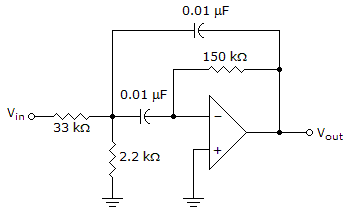
A. band-pass
B. band-stop
C. high-pass
D. low-pass
Answer: Option B
Solution:
825. Refer previous figure. The roll-off of this filter is about

A. 20 dB/decade.
B. 40 dB/decade.
C. 60 dB/decade.
D. 80 dB/decade.
Answer: Option A
Solution:
826. Negative feedback added to an op-amp ________ the bandwidth and ________ the gain.
A. increases, increases
B. increases, decreases
C. decreases, decreases
D. decreases, increases
Answer: Option B
Solution:
827. What type of amplifier is a current shunt configuration?
A. Voltage
B. Current
C. Transconductance
D. Transresistance
Answer: Option B
Solution:
828. Determine the input and output impedance with feedback for voltage-series feedback having A = -100, Ri = 10 kΩ, and Ro = 20 kΩ for feedback of β = -0.1.
A. 909.09 Ω, 1.82 kΩ
B. 909.09 Ω, 220 kΩ
C. 110 kΩ, 392.16 Ω
D. 110 kΩ, 1.82 kΩ
829. An amplifier with a gain of –500 and a feedback of β = –0.1 has a gain change of 15% due to temperature. Calculate the change in gain of the feedback amplifier.
A. 0.2%
B. 0.3%
C. 0.4%
D. 0.5%
830. This circuit is a ________ oscillator.
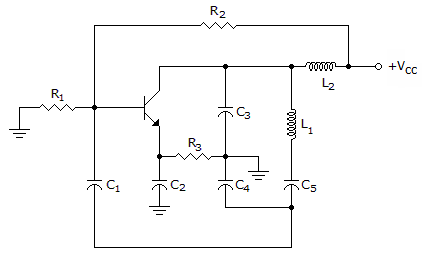
A. Wien bridge
B. Clapp
C. Colpitts
D. Hartley
Answer: Option B
Solution:
831. The attenuation of the three-section RC feedback phase-shift oscillator is
A. 1/9.
B. 1/30.
C. 1/3.
D. 1/29
Answer: Option D
Solution:
832. Refer to this figure. Calculate the resonant frequency.

A. 1.126 kHz
B. 6.17 kHz
C. 23.9 MHz
D. 14.1 MHz
833. In order to start up, a feedback oscillator requires
A. negative feedback less than 1.
B. positive feedback greater than 1. B
C. unity feedback equal to 1.
D. no feedback.
Answer: Option B
Solution:
834. Calculate the resonant frequency of this oscillator.
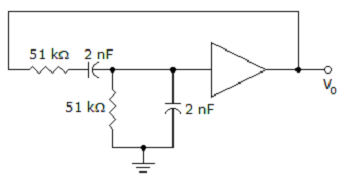
A. 1560.34 Hz
B. 3120.70 Hz
C. 4681.07 Hz
D. 6241.37 Hz
835. What is the total phase shift requirement, around the feedback loop, for a phase-shift oscillator?
A. 90°
B. 180°
C. 270°
D. 360°
Answer: Option D
Solution:
836. At series resonance, the impedance of a crystal is
A. minimum.
B. maximum.
C. equal.
D. zero.
Answer: Option A
Solution:

837. For frequencies up to 1 MHz, the ________ is the most widely used type of sinusoidal RC oscillator.
A. Wien-bridge
B. phase-shift
C. twin-T
D. Colpitts
Answer: Option A
Solution:
838. The twin-T oscillator produces a ________ response.

A. low-pass
B. high-pass
C. band-pass
D. band-stop
Answer: Option D
Solution:
839. What is the typical value of quality factor for crystal oscillators?
A. 20,000
B. 1000
C. 100
D. 10
Answer: Option A
Solution:
840. Refer to this figure. Determine the frequency of oscillation, if any.
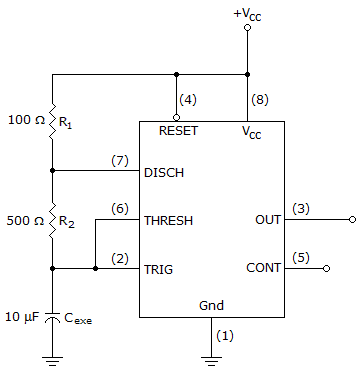
A. 131 Hz
B. 262 Hz
C. 2.62 kHz
D. none
841. Determine the frequency of oscillation given VBB = 12 V, R1 = 0.1 kΩ, R2 = 0, RT = 50 kΩ, CT = 0.1 pF, η = 0.6
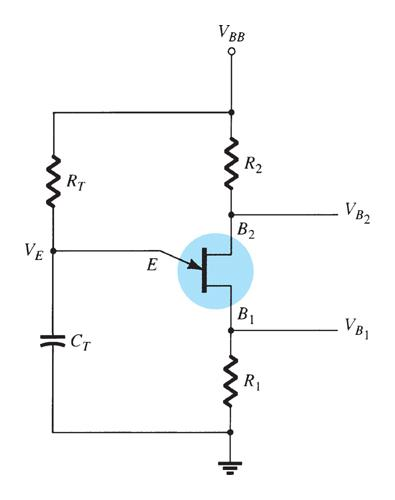
A. 281.27 Hz
B. 218.27 kHz
C. 218.27 MHz
D. 281.27 MHz
Questions and Answers in Electronic Circuits
Following is the list of practice exam test questions in this brand new series:
Complete List of MCQ in Electronics Engineering per topic
P inoyBIX educates thousands of reviewers and students a day in preparation for their board examinations. Also provides professionals with materials for their lectures and practice exams. Help me go forward with the same spirit.
“Will you subscribe today via YOUTUBE?”
TIRED OF ADS?
- Become Premium Member and experienced fewer ads to ads-free browsing.
- Full Content Access Exclusive to Premium members
- Access to PINOYBIX FREEBIES folder
- Download Reviewers and Learning Materials Free
- Download Content: You can see download/print button at the bottom of each post.
PINOYBIX FREEBIES FOR PREMIUM MEMBERSHIP:
- CIVIL ENGINEERING REVIEWER
- CIVIL SERVICE EXAM REVIEWER
- CRIMINOLOGY REVIEWER
- ELECTRONICS ENGINEERING REVIEWER (ECE/ECT)
- ELECTRICAL ENGINEERING & RME REVIEWER
- FIRE OFFICER EXAMINATION REVIEWER
- LET REVIEWER
- MASTER PLUMBER REVIEWER
- MECHANICAL ENGINEERING REVIEWER
- NAPOLCOM REVIEWER
- Additional upload reviewers and learning materials are also FREE
FOR A LIMITED TIME
If you subscribe for PREMIUM today!
You will receive an additional 1 month of Premium Membership FREE.
For Bronze Membership an additional 2 months of Premium Membership FREE.
For Silver Membership an additional 3 months of Premium Membership FREE.
For Gold Membership an additional 5 months of Premium Membership FREE.
Join the PinoyBIX community.


